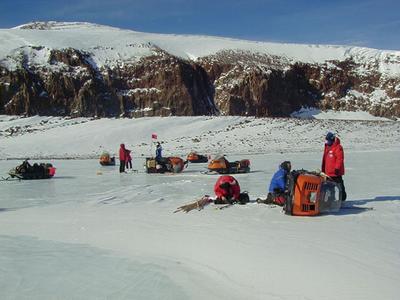28 December, 2002
Another day in the life of ANSMET...
No day of meteorite collecting in Antarctica is routine, but a certain
regularity has set in. Nancy says that this usually happens around this
time when we've been searching for a little over three weeks and still have
almost three to go. I've noticed people in our group with questions about
the upcoming pull-out and I must admit that some of my thoughts have turned
to my New Zealand itinerary and what I'm going to do first when I get back
to work at the high school. I think all of us are looking forward to
showers and sleeping indoors again.
Today started like most. We woke at 7:00AM, but this morning the tent was
about 10 degrees colder than normal. I heard the wind outside and was not
as motivated as I could have been. We went back to Quiche Moraine,
thinking that we would finish it up, but instead we recovered another 16
meteorites there, and some that don't fit the pattern we thought we
established. It looks like we still have some of Quiche leftover.
At 11:00, Nancy and Jamie led us back to the "Mouthy Ice," a large blue ice
field on the plateau above us that is shaped on the satellite photo like a
giant mouth. They try to mix up the agenda every day so that we don't get
bored searching the same moraine or ice field day after day. About the
time we got up there, the wind died and the temperatures began to
climb. We systematically searched for a couple of hours and Scott found
the only meteorite of the area we searched. We barely scratched the
surface of all there is to find there.
The Mouthy Ice area was originally searched by an ANSMET reconnaissance
team in 1986-'87 and again the next year. They didn't systematically
search it but still found several meteorites. I actually like the
systematic searching better than the searching in the moraines. Today we
seemed to get several breaks during the time we were setting up each
sweep. Many of us would lay back on our Ski-doos and stare at the
sky. The sky is very blue here, like the sky in Colorado, and for the same
reason, elevation. Occasionally we see contrails left by the LC-130's going
between the Pole and McMurdo. The contrails curve to match the curvature
of the Earth. The poles are the only places that this phenomenon is
visible. Another phenomenon we see frequently are sundogs, rainbow colored
circles around the sun caused by the refraction of light through ice
crystals in the upper atmosphere. When all the Ski-doos are shut off,
it's perfectly quiet and peaceful. Then Scott starts singing hits of the
'70's and '80's and we are ready to go.
The ice today was very hard on the Ski-doos. At one point, two of them had
broken bogey wheels and another was having engine trouble. Bogey wheels
act as the suspension for the snowmobiles and are fairly easily
replaced. I usually have a couple of spares under the seat of my Ski-doo.
We did most of the repairs on a patch of blue ice that was really on the
outskirts of our search area. Most blue ice is rippled and rough, but this
looked like a frozen pond. If we had skates, we could have started a
hockey game. We only found one meteorite here, but the area was beautiful.
It was basically a large natural amphitheater surrounded by cliffs of a
dark rock called the Ferrar Dolerite. This is a dark, igneous rock that
was formed 180 million years ago when Antarctica separated from the
Gondwanaland supercontinent. It looks a lot like it's close relative,
basalt. Basalt is always the "word of the day" in my classroom. If
someone says, "basalt," they get a high five from me. It's silly, but it
keeps my students awake. If they were here today, high fives would be
going all around.
We drove up on a moraine adjacent to these cliffs and searched the
windscoops for meteorites. Scott pointed out that since this place wasn't
searched by the earlier ANSMET team, we could very likely be the first
people. Danny commented that we were going... "Where no man has gone
before..." It's exciting thinking your footsteps may be the first in an
area or that you may be the first to lay eyes on a rock. These cliffs were
impressive, standing over 500 ft. tall and capped with pure white snow on
top. At some angles, they almost looked like a giant ice cream cone.
We searched one more windscoop on the way back and challenged each other to
see who could climb the furthest up the steep ice face. Inside the
windscoop, the ice looks like a five-story frozen ocean wave; frozen right
before it crashes. Scott and Danny wound up cutting footholds in the
ice. We would climb up and slide on our backs all the way back down to a
snowy landing at the bottom. The more complex the mind, the greater the
need for play.
Tonight, we are expecting a call from the Rekki team. Nancy will be
excited to tell them that we've found over 300 meteorites. Mild
temperatures and a little sledding go a long way in keeping this team
motivated to find meteorites.

Ski-doos in need of field repairs in paradise.
Contact the TEA in the field at
.
If you cannot connect through your browser, copy the
TEA's e-mail address in the "To:" line of
your favorite e-mail package.
|
